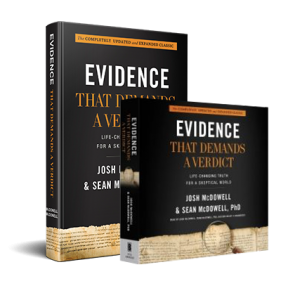The historical reliability of the Bible can be tested by the same criteria by which all historical documents are tested. The Christian faith, after all, is tied to specific historical events that can be confirmed through multiple sources. It is not, as one critics assert, “just a bunch of made-up stories.”
Donald Hagner, professor emeritus of New Testament at Fuller Tehological Seminary, explains the connection between the Christian faith and real historical events this way:
“True Christianity, the Christianity of the New Testament documents, is absolutely dependent on history. At the heart of the New Testament faith is the assertion that “God was in Christ reconciling the world to Himself” (2 Corinthians 5:19). The incarnation, death, and resurrection of Jesus Christ as a real event in time and space, i.e., as historical realities, are the indispensable foundations of the Christian faith. To my mind, then, Christianity is best defined as the recitation of, the celebration of, and the participation in God’s acts in history, which as the New Testament writings emphasize have found their culmination in Jesus Christ.“
Tests to Prove Gospel Reliability
Three specific tests that scholars, researchers, and archaeologists use to determine a document’s authenticity include the bibliographical test, the internal evidence test, and the external evidence test.
As the original autographs of the New Testament books have not been found, scholars must examine the early handwritten copies of these Scriptures. Do they stand up to the question of “Is this really true?” Or are Christians simply clinging to “blind faith”?
We like what Dr. Steven Collins says in the start of his talk titled “Confirming the Bible Through Archaeology“:
“If the realities of the events and the world presented to us on the pages on the Bible didn’t actually occur, then where in the world do we get off on trying to believe and place our lives on the invisible stuff? If you can’t trust the Bible for what you can see and test and dig up, then all of that other stuff, how would you put your trust in that? I don’t think it would be a smart bet to do it!”
Dating the Four Gospels and Book of Acts
When scholars assign dates to manuscripts, we find that those dates sometimes vary not just by a few years or even decades but even by centuries. Why is this? One major reason is the personal worldview and and presuppositions that scholars and researchers bring to their study of Scripture.
Conservative scholars tend to date the New Testament Gospels earlier that do liberal scholars. Conservative scholars, for example, date the book of Matthew to be early AD 60s-80, while liberal scholars date the writings at AD 80-100. Conservative scholars date the book of John at mid AD 60s-100, liberal scholars date the writing at AD 90-100. All scholars, however, typically place the date of Jesus’ death around the year AD 30, and Paul’s letters (the earliest New Testament books) in the decade of the 50s. So we can use those dates as starting points.
Matthew
When was this gospel written? A confirmation of the date of Matthew’s writing comes from an external source: a report by Irenaeus, a second-century church father, who said that Matthew composed his gospel “while Peter and Paul were preaching the Gospel and founding the church in Rome.” The only time that we know that Peter and Paul were together in the capitol of the Roman Empire was the early to mid-60s.
Those who reject this timing do so because Matthew writes of Jesus predicting the destruction of the temple in Jerusalem (Matthew 24: 1, 2), which happened in AD 70. These scholars argue that Matthew must have been written after the event, because they don’t believe in predictive prophesy. But if it can be demonstrated that supernatural events can and do, occur, this argument simply doesn’t hold up.
Another reason scholars give for proposing a later date relates to Matthew’s writing of the tensions between Pharisaic Judaism and Christian Judaism. Some argue that these tensions reflect the latter half of the first century, during the war with Rome that left these groups as the only two surviving forms of Judaism. This argument, however, ignores that the tensions had already started in the 60s. Matthew records Jesus at odds with Sadducees and other leaders, not just the Pharisees.
A third reason for proposing a later date for the gospel of Matthew is that the book of Mark was likely written first, and Mark is thought to have been written in the 70s. But Mark could very well have been written in the later 50s or 60s.
Mark
Though many scholars believe the book of Mark was the first gospel written, probably within 25 years of Jesus ascending to heaven, it is notoriously difficult to date. Early church tradition defines Mark as an associate of Peter. This is because of the considerable amount of attention the gospel of Mark gives to Peter, and the fact that Peter is mentioned near the beginning and the end of the narrative (Mark 1:16, 16:7). The majority of Mark’s oral materials were the result of his regular contact with Peter. Mark would most likely have been written before Peter was martyred (AD 65), or shortly thereafter.
A bilingual Hellenist, John Mark — John was his Hebrew name and Mark his Greek name — was a cousin of the wealthy Cyprian landowner Barnabas (Colossians 4:10, Acts 4:36), and would have been a very young man at the time of Christ’s crucifixion. His wealthy family occupied a significant place in early Christian communities, first in Jerusalem and later Antioch. His mother’s house in Jerusalem served as a gathering point for believers; Mark would have interacted with these believers closely.
Peter, later writing from Rome, would refer to Mark as “my son” (1 Peter 5:13), giving evidence of the closeness of their relationship. Mark joined his cousin Barnabas and Paul in their early travels from Antioch (Acts 12:25; 13:2-3) and, in spite of a falling out (Acts 13:13; 15:36-39), Mark later worked closely with Paul, even being summoned to Paul’s last imprisonment in Rome (2 Timothy 4:11). Some of Mark’s insights into Jesus’ significance may have come from Paul, to whom Jesus appeared (1 Corinthians 15:8).
Luke-Acts
The gospel of Luke and the book of Acts are often referred to together as “Luke-Acts” because Luke wrote both of these accounts, probably within a close time period. Although the date of Luke continues to be debated, it is generally agreed that Luke wrote his gospel before Acts and after Mark. Luke’s writings talk about Jesus’ ministry, and provide an account of the progress of the gospel after His death. Although Luke does not explicitly quote from Paul’s letters, his writings reflect the influence of Paul’s thoughts. The best estimate for the dating of Acts places the work between AD 62 and 64. Some factors can be listed that make a strong case for this:
* Luke mentions the city of Jerusalem about 30 times in his gospel, and about 60 times in the book of Acts; far more times than any other New Testament writer. Luke fails to mention the destruction of the Jewish temple, which took place in AD 70. It makes sense, then, to date the book of Acts before the temple was destroyed.
* Acts does not mention the severe persecutions of the Roman emperor Nero, which started in the mid-60s. If written during this period, surely Luke would have recorded this dark period of the early church. Luke does not mention the wars against the Romans, which began in AD 66.
* Luke records the martyrdoms of Stephen and James the brother of John, but is silent on the martyrdoms of Peter, Paul, and James. These three prominent figures died between AD 61 and 67. If Luke wrote Acts after their deaths, he probably would have recorded them in his history of the early church.
John
Throughout John’s gospel, we see Jesus in human form, compassionately interacting with the very humanity for whom He came to save. That makes it, perhaps, the most relatable gospel. John’s single focus: for us to recognize that Jesus is the Christ.
Scholars suggest a wide possible timeframe for the date of John’s writings; that any date between about AD 55 and 95 is possible. This is because no argument tied to a specific date is entirely convincing. Because of John’s emphasis on Jesus as the divine Son of God, however, many liberal scholars lean toward a later writing date, supposing that such a high view of Jesus’ divinity did not form until later in history. Some scholars believe John’s gospel was penned shortly before his letters, which were written in the 90s in response to gnostic misinterpretations of his gospel. This would place his gospel as likely being written in the 80s.
The Question to Ask of the Gospels
It is doubtful that there ever was a substantial period of time in which the early church lacked written accounts of Jesus’ ministry; it’s more a question of recognizing that the materials on which they were written had a limited shelf life. As we covered in a previous post, the early writers had to rely on papyrus and parchment. We’re fortunate for the availability of eyewitnesses and the reliability of oral tradition, as well as the fact that for centuries Scripture has been scrutinized to confirm its God-breathed truth.
It can be reasonably argued that all four biographies of Jesus, as well as the book of Acts, were written within a few decades — and certainly within a century — of the events they describe. Even most non-Christian scholars acknowledge this and place the canonical Gospels and Acts securely within the first century. But even if a radically late dating were correct, we would still have records for the events surrounding the origin of Christianity that are earlier than those sometimes used to support unquestioned events in history.
So, knowing that the Gospels enjoy historical validation, let’s look at their message. Are the Gospels true? Why do we need to care? Pastor Steven J. Cole has a ready answer:
“If Jesus is who the Bible portrays Him to be and who He claimed to be—the Christ (Messiah), the Son of the living God—then the only sensible response is to trust Him as your Savior from sin and judgment and to follow Him as your Lord. If He is not who the Bible portrays Him to be, then you’re wasting your time being a Christian, because you’re following a fictional character. ‘Who do you say that I am? is the crucial question in life!”
The Bible is God’s Word to us, and the Gospels his Love Song. Have confidence that God longs to have a relationship with you. We can trust the Good News!

This blog post highlights Josh and Sean McDowell’s recently revised apologetics classic, Evidence That Demands a Verdict. We are certain this fully updated and expanded resource will be an effective evangelism tool for you, and strengthen your faith by answering the toughest questions tossed to you by skeptics. Know what you know, because it’s true. But share this truth with LOVE!




